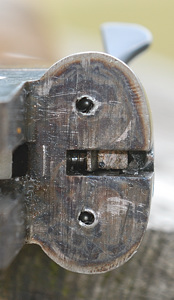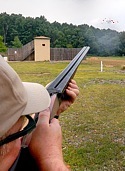|
|

|
|
|
||||||||||
by David Alan Woolsey
That leaves over-unders, or side-by-side guns. The over-under guns tend to be at the more expensive end of the spectrum, and the side-by-side guns can be expensive as well, since many people who buy just to hunt gravitate to repeating guns. That leaves the double guns (side-by-side - sometimes abbreviated as "SxS" - and over-under, or "O/U") in a smaller market, and basic economics work to raise prices on items with a smaller, niche consumer group. Fear not! The answer is a good, used gun. As used over-under guns are often still expensive (when they aren't junk), the choice is then a good, used, side-by-side gun. The side-by-side shotgun was the most widely made style of breech loading shotgun in the world for many decades. Consequently, there is a vast variety of quality levels (sometimes referred to as grades) of such guns on the market. Inexpensive, well-made guns can be found. For a few dollars, an inexpensive gun may be "tweaked" into a very versatile shooting iron. The term grade, when referring to shotguns, generally refers to the outward appearance of the gun, as well as the quality of the internal parts. The attention to detail of the fit and action of those parts is also a factor. Grades of shotguns are relative, and it is the decision of each gun manufacturer whether to produce a product in different grades. As grade is determined by each company, the quality of a "low grade" shotgun from one company might surpass the "best grade" from another company. The shooting public often determines how each company's grade of guns compare. Grade often only refers to the outward appearance of metal and wood. A low grade L.C. Smith for example, will shoot as well as the top grade model, but the low grade won't look as pretty while on display in the gun cabinet. For the beginner, a gun that shoots well is the most important factor. A pretty gun that throws a poor pattern will miss, and miss often. Worse, a shooter may develop bad habits to compensate for the shortcomings of a particular gun. The worst that could happen would be a shooter - out of disappointment over performance so inexplicably bad that he feels he must simply not have the capacity to ever do well - that abandons gunning as a pastime. It is, as the saying goes, a poor craftsman that blames the tools for his troubles... but sometimes it is the tool, either in its design, or in its suitablity to the person using it. Indeed, one may find an experienced shooter with a plain gun, who appears never to miss at the range or in the field. That shooter has a good shooting, well-fitted gun, and has learned to use it well. Hence the warning among competitive target shooters, "Beware of the shooter who owns but one gun". There is an additional advantage to the plain, good shooting gun. Americans normally do not stand in lines firing at released birds; they walk afield. As such, the tools that accompany them in the rougher going will be scratched, stocks will be marred, and the guns will be exposed to the elements. A plain, used gun may be dinged up a bit. This is not a loss, while the merest scratch on a custom collector's piece may mean devaluation by hundreds of dollars, or worse. When in the field a hunter needs to be concerned with safety, reliability, and accuracy - not with the cosmetic exterior of the shotgun. His bird dog will not be impressed by heartbreakingly beautiful case coloring or inlay work, but rather by a nice plump gamebird falling stone dead from the sky.
So, to cover this ground from the perspective of a gunner without a gun, we started from scratch and the search for a workable side-by-side shotgun began. After perusing the used gun rack at a trustworthy local dealer, a Savage-Stevens Model 311A jumped right out. A good, serviceable side-by-side shotgun, it was in the author's favorite gauge: sweet sixteen. The gun was probably made in the 1950's, and had no exterior serial number. The blue book value for the gun in perfect condition was only $250. As this was a used gun with typical wear, the gun was obtained for under $200. That's a price any new shooter could afford. Over the lifetime that it will be used, that price will turn out to be less, per outing at the range or in the field, than the shells that will be fed through it.
The opened firing pin ports might be a problem when the gun is fired. Pressure inside the shells is applied to the primers as well as the rest of the shell. That pressure might cause the primers to pierce, and send hot gases into the action. Such venting is not terribly dangerous to a shooter who is wearing safety glasses. However, a small amount of gases venting into the action will soon create mechanical problems. If the primers aren't pierced, they may deform backwards into the opened ports. This could make it tough to open the action after firing. Very annoying on the range and in the field to say the least, and also a safety issue if one shot was taken (there still being a live shell in the other chamber). With a bit of luck, and firing shells not loaded to extremes, the gun might shoot well without any noticeable primer problems. The gun was purchased from Atlantic Guns in Rockville, Maryland, and all of their used guns are checked for function by their accomplished gunsmith, Walter Frear. I was confident that the gun would work well. The gun had a plain, wooden stock (probably birch), with a semi-pistol grip. The action was simple, with a pair of triggers, with the front trigger firing the right barrel, and the rear trigger firing the left. The blued finish was in acceptable condition. The barrels had a small, single bead at the muzzle. I have found that when hunting, I prefer the dual trigger gun. Dual triggers allow me to instantly choose which barrel to fire, depending on the range to the bird. Single trigger guns, without a selector switch, always fire the same barrel first. This is an unacceptable option for the hunter as it requires a wasted shot on a bird that flushes at medium range. More expensive single-trigger guns usually have a selector switch built into the safety, or into the trigger. Neither type of selector switches allow the hunter to quickly select the barrels after the bird has flushed. Selector switches are more suited to the target range.
A check of the patterns from both barrels showed patterns that were a bit less than uniform, with the modified choke pattern rather ragged. Comparing both chokes, the left barrel threw a pattern thirty seven percent tighter than the right barrel. The left barrel then would throw an effective pattern about forty-one yards, with the right barrel throwing an effective pattern out to about thirty yards. (The CZ shotgun tested at the same time had much more uniform patterns, with the modified barrel choked only twenty-five percent tighter than the right barrel). Why would a manufacturer tighten the left barrel's choke a bit more than traditionally? As an "all around" gun of the late 1940's or the 1950's, removable, interchangeable choke tubes were not available. A slightly tighter, modified choke would give the gun a tighter pattern over a longer distance. Ducks and geese are typically shot at longer range than field birds, so the gun would be acceptable for waterfowl. If this was the case, the pattern from the left barrel would be tight, and at close range a less than perfect shot would miss. That would explain why the majority of misses from this gun were from the left barrel. (It might also be the shooter's fault, but for the sake of my ego, we'll assume it to be a choke problem for now.) It was decision time. The gun shot fine, was inexpensive, and could work with success for birds and small game. Unmodified, the gun could be used for waterfowl and squirrel, as well as field birds and rabbit. When hunting grouse or quail, however, the hunter might experience a couple of problems. With the modified choke in the left barrel, the hunter might suffer some misses with the left barrel at close range. The other problem was that at close range, the tighter pattern from the left barrel would place a huge amount of shot into the birds, probably ruining them for the pot (let's be honest, the birds are being hunted because they are yummy). The decision was made to try and "tweak" the barrels to increase the versatility of the gun, while not breaking the bank. The first step was to remove the chokes from the end of the barrels. A simple modification (DO NOT try this at home), the barrels would be taken to a gunsmith. The gunsmith would shorten the barrels by two inches, thus removing the choked portion. At that point the gun could be fitted with a new bead on the rib between the ends of the barrels. The gun would then have a different balance, to which the shooter would have to become accustomed. The gun would also have barrels without choke, also known as cylinder bore. Cylinder bore barrels throw the widest possible shot pattern. As such, the gun would be excellent at close range (25 yards or less) on dove, quail, rabbit, or grouse. The gun would also be acceptable for skeet. Pheasants hunted with an unchoked gun might be a problem, as the lack of choke would put a smaller amount of pellets into the bird at longer ranges. Waterfowl would be out of the question. Still, such a modification would be the least expensive option, and some shooters only want to shoot the smaller birds (and perhaps an occasional rabbit). The gun was taken back to Atlantic Guns for the modification to be made. In Part Two, we will examine the uniformity of the patterns to see if the gun has been improved with the removal of the chokes. We'll also shot-test the gun to see if the clay bird average has been improved. -UL |
||||||||||
|
^Top | Home | About UplandLife.com | Contact Us | Advertising/Listings | Privacy / Policies | Site Map Entire contents copyright © 2025 UplandLife.com, All Rights Reserved. Content Technology From NorseCode. |
 A new, old friend: the Savage-Stevens 311A
A new, old friend: the Savage-Stevens 311A Firing pin port wear, not unusual for a decades-old shotgun.
Firing pin port wear, not unusual for a decades-old shotgun. Test driving side-by-sides at the skeet range.
Test driving side-by-sides at the skeet range.